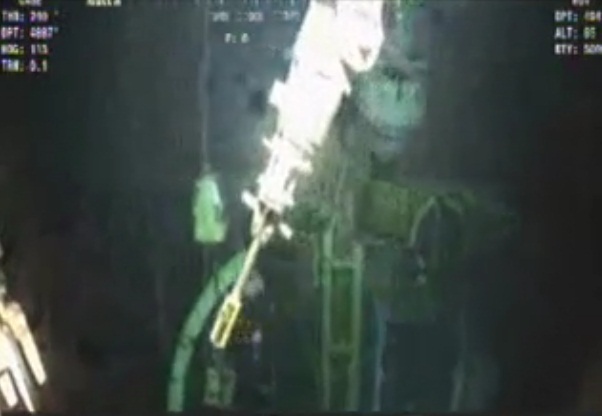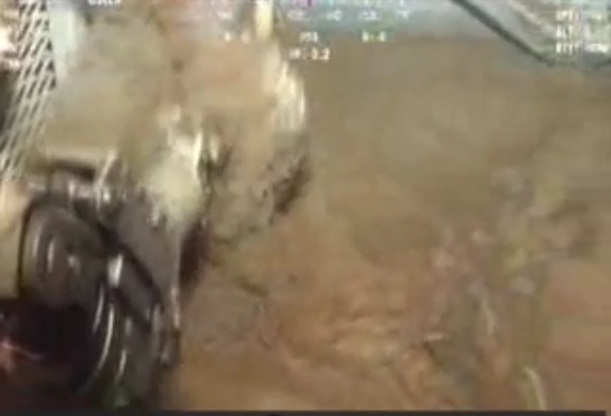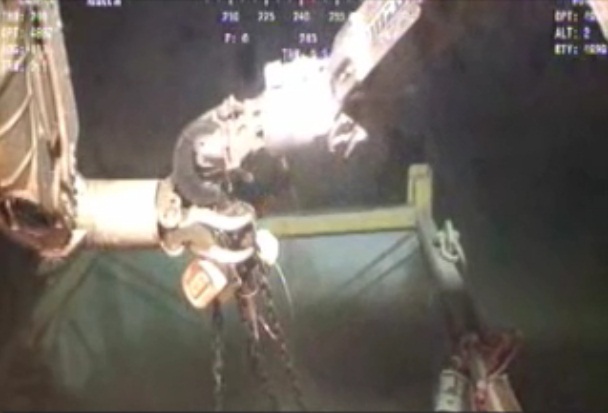The government failed to properly ensure that BP used adequate safety measures, BP and their contractors were criminally negligent for the oil spill, and BP has tried to cover up the problem. See this.
But why hasn't BP stopped the leak?
Some people assume that BP hasn't stopped the oil leak because it's people are wholly incompetent.
Others have asked whether BP's $75 million liability cap is motivating it to stall by taking half-hearted measures until it's relief well drilling is complete.
But there is another possible explanation: the geology - as well the deepwater pressures - at the drilling site makes stopping the leak more difficult than we realize.
Does the Geology of the Spill Zone Make It Harder to Stop the Oil Spill?
We can't understand the big picture behind the Gulf oil spill unless we know the underwater geology of the seabed and the underlying rocks.
For example, if there is solid rock beneath the leaking pipes, with channels leading to various underground chambers, then it might be possible to seal the leaking risers and blowout preventer, with the oil flowing somewhere harmless under the floor of the ocean.
On the other hand, if there are hundreds of feet of sand or mud beneath the leaking pipes, then sealing the spill zone might not work, as the high-pressure oil flow (more than 2,000 pounds per square inch) might just shoot out into the water somewhere else.
We don't know the geology under the spill site. BP has never publicly released geological cross-sections of the seabed and underlying rock. BP's Initial Exploration Plan refers to "structure contour maps" and "geological cross sections", but all detailed geological information, maps and drawings have been designated "proprietary information" by BP, and have been kept under wraps.
However, Roger Anderson and Albert Boulanger of Columbia University's Lamont-Doherty Earth Observatory describe the basic geology of the oil-rich region of the Gulf:
Production in the deepwater province is centered in turbidite sands recently deposited from the Mississippi delta. Even more prolific rates have been recorded in the carbonates of Mexico, with the Golden Lane and Campeche reporting 100,000 barrel per day production from single wells. However, most of the deep and ultra-deepwater Gulf of Mexico is covered by the Sigsbee salt sheet that forms a large, near-surface “moonscape” culminating at the edge of the continental slope in an 800 meter high escarpment.
***
Salt is the dominant structural element of the ultra-deepwater Gulf of Mexico petroleum system. Large horizontal salt sheets, driven by the huge Plio-Pleistocene to Oligocene sediment dump of the Mississippi, Rio Grande and other Gulf Coast Rivers, dominate the slope to the Sigsbee escarpment. Salt movement is recorded by large, stepped, counter-regional growth faults and down-to-the-basin fault systems soling into evacuated salt surfaces. Horizontal velocities of salt movement to the south are in the several cm/year range, making this supposedly passive margin as tectonically active as most plate boundaries.
***
Porosities over 30 percent and permeabilities greater than one darcy in deepwater turbidite reservoirs have been commonly cited. Compaction and diagenesis of deepwater reservoir sands are minimal because of relatively recent and rapid sedimentation. Sands at almost 20,000 feet in the auger field (Garden Banks 426) still retain a porosity of 26% and a permeability of almost 350mdarcies. Pliocene and Pleistocene turbidite sands in the Green Canyon 205 field have reported porosities ranging from 28 to 32% with permeabilities between 400 mdarcies and 3 darcies. Connectivity in sheet sands and amalgamated sheet and channel sands is high for deepwater turbidite reservoirs and recovery efficiencies are in the 40-60% range.
See also this.
The BP oil spill leak is occurring in Block 252 of the "Macondo" Prospect in the Mississippi Canyon Area of the Gulf. The Mississippi Canyon Area is very typical of the Gulf oil region.
If the geology at Block 252 is like that described by Anderson and Boulanger for the Gulf oil region as a whole, then it might be difficult to stop the oil gusher without completing relief wells (which will take a couple of months). Again, if there are salt layers right under the sea floor, high porosity near the surface or salt movement, then sealing the leak by plugging the risers and blowout preventer might not work. The oil pressure is coming up at such high pressures that sealing the leaking equipment at the level of the seabed might just mean the oil will flow out somewhere else nearby.
The government must publicly release details of the geology under the spill site. The American people - and people in Mexico, Cuba and other countries which might be affected by the spill - have a right to know what we're dealing with.
Until it does so, people will not have be understand what is going on. And failing to release such information may prevent creative scientists from around the world from coming up with a workable solution.
Moreover, as the first draft of Anderson and Boulanger's paper - released in 2001 - noted:
No means currently exists to produce oil and gas to market from such water depths!
(exclamation point is Anderson and Boulanger's). In other words, the technology to drill in such deepwater conditions in the Gulf has only been developed after 2001.
While BP, its subcontractors, and the government were all negligent with regard to the Deepwater Horizon operation, it must be remembered that drilling at such depths is new technology, operating in largely uncharted conditions. As such, the dangers of deepwater drilling in general should not be underestimated. The geology of the oil-rich region in the Gulf - as well as the deep, high-pressure conditions - makes drilling difficult, and containing oil spills challenging.
Oil Is Considered A National Security Issue
So why are oil companies being allowed to drill so deeply under the Gulf in the first place? In other words, why has the government been so supportive of deepwater drilling in the Gulf?
The answer - as Anderson and Boulanger note - is that there is a tremendous amount of more oil deep under the Gulf, and that the United States government considers oil drilling in the deep waters of the Gulf as a national security priority:
The oil and gas industry and the United States government both face tremendous challenges to explore discover, appraise, develop, and exploit vast new hydrocarbon reserves in waters deeper than 6000 feet in the ultra-deepwater of the Gulf of Mexico. Yet these new reserves of hydrocarbons are needed to offset the economically detrimental, long-term decline in production from within the borders of the United States
***
If successfully developed, the new play concept would fill an essential gap in the overall strategic defenses of the United States by decreasing the gap that results in the nation's dependence on foreign oil and gas reserves in this volatile and hostile, post 9/11 world. However, the successful production of oil and gas from this new carbonate play concept requires much more cost-efficient evaluation and appraisal technologies than exist today to economically conduct exploration, appraisal, and development activities. These new technologies must be developed before production can be practical in the ultra-deepwater operating environment.... The Ultra-Deepwater and Unconventional Gas Trust Fund of the DOE has as its mission to cut costs and time-to-market not incrementally, but radically, so that the United States can optimally utilize these strategic hydrocarbon reserves. The DOE, with extensive industry,academic and non-governmental assistance, developed an Offshore Technology Roadmap ...,
***
The U. S. Energy Bill of 2002 has allocated significant resources to fund innovative industry, academic, and national laboratory research initiatives to develop the new technologies necessary to explore and produce these new ultra-deepwater reserves economically. The purpose is not only to impact the national defense, but also to regain our international technological leadership in the deepwater, recently lost to the Brazilians, Norwegians, and Europeans.
***
Congress, never a big friend to energy interests, has acted to create the Ultra-deepwater Trust Fund that would add an astounding $200 billion by 2017, if successful at developing the new production technologies required.
So the Department of Energy and Congress have committed to development of the deepwater Gulf oil reserves in the name of national security. This also helps explain why Obama has been pro-drilling in the Gulf.
But let's take a step back and ask why the government considers oil a national security priority in the first place.
Well, as professor of national security affairs at the Naval War College Mackubin T. Owens writes:
The concern of these lawmakers [regarding the BP oil spill] is understandable, but lest they overreact, they need to place their valid concerns within the broader context of the nation’s economic health and energy security.
***
Americans currently consume about 22 million barrels of oil daily, of which about two-thirds is imported. The Department of Energy’s Energy Information Administration (EIA) expects imports to reach 70% by 2025. This means we send billions of dollars abroad in payment for foreign oil. This makes little sense when, according to the U.S. Minerals Management Service (MMS), there are vast reserves of oil and gas beneath Federal lands and coastal waters. And it is likely that even these estimates are low. For instance, in 1987, MMS estimated that there were 9 billion barrels of oil in the Gulf of Mexico. By 2007, once drilling had begun in deeper waters, MMS had revised its estimate upward to 45 billion.
In addition, the U.S. military is the largest consumer of oil in the world. And the government is eager to ensure that the military maintains access to oil.
As NPR reported in 2007:
All the U.S. tanks, planes and ships guzzle 340,000 barrels of oil a day, making the American military the single-largest purchaser and consumer of oil in the world.
If the Defense Department were a country, it would rank about 38th in the world for oil consumption, right behind the Philippines.
As Reuters pointed out in 2008:
U.S. military fuel consumption dwarfs energy demand in many countries around the world, adding up to nearly double the fuel use in Ireland and 20 times more than that of Iceland, according to the U.S. Department of Energy.
And as I summarized last year:
Sara Flounders writes:
By every measure, the Pentagon is the largest institutional user of petroleum products and energy in general. Yet the Pentagon has a blanket exemption in all international climate agreements.
***
The Feb. 17, 2007, Energy Bulletin detailed the oil consumption just for the Pentagon's aircraft, ships, ground vehicles and facilities that made it the single-largest oil consumer in the world.
***
Even according to rankings in the 2006 CIA World Factbook, only 35 countries (out of 210 in the world) consume more oil per day than the Pentagon.
***
As I pointed out out last week:
Professor Michael Klare noted in 2007:
Sixteen gallons of oil. That's how much the average American soldier in Iraq and Afghanistan consumes on a daily basis -- either directly, through the use of Humvees, tanks, trucks, and helicopters, or indirectly, by calling in air strikes. Multiply this figure by 162,000 soldiers in Iraq, 24,000 in Afghanistan, and 30,000 in the surrounding region (including sailors aboard U.S. warships in the Persian Gulf) and you arrive at approximately 3.5 million gallons of oil: the daily petroleum tab for U.S. combat operations in the Middle East war zone.
And in 2008, Oil Change International released a report showing that [b]etween March 2003 and October 2007 the US military in Iraq purchased more than 4 billion gallons of fuel from the Defense Energy Support Center, the agency responsible for procuring and supplying petroleum products to the Department of Defense.
Indeed,
Alan Greenspan,
John McCain,
George W. Bush,
Sarah Palin, a
high-level National Security Council officer and others all say that the Iraq war was really about oil.
Nobel prize winning economist Joseph Stiglitz says that the Iraq war alone will cost $3-5 trillion dollars.
And economist Anita Dancs writes:
Each year, our military devotes substantial resources to securing access to and safeguarding the transportation of oil and other energy sources. I estimate that we will pay $90 billion this year to secure oil. If spending on the Iraq War is included, the total rises to $166 billion.
Are you starting to get the picture?
In addition, experts say that the Iraq war has increased the threat of terrorism. See this, this, this, this, this, this and this.
Personally, I strongly believe that it is vital for our national security - and our economy - to switch from dependence on oil to a basket of alternative energies. As I pointed out Friday:
It's not just the one BP oil rig. For example, since the Deepwater Horizon oil drilling rig exploded on April 20th, the Obama administration has granted oil and gas companies at least 27 exemptions from doing in-depth environmental studies of oil exploration and production in the Gulf of Mexico. Then there are the 12 new oil and gas drilling rigs launched in the U.S. this week.
And a whistleblower who survived the Gulf oil explosion claims in a lawsuit that BP's operations at another oil platform risk another catastrophic accident that could "dwarf" the Gulf oil spill, partly because BP never even reviewed critical engineering designs for the operation. And see this.
***
And the Department of Defense also apparently has some issues with extensive off-shore drilling for security reasons.
Many still believe that alternative energy is an expensive, unrealistic pipe dream.
But that is no longer necessarily true, especially when the externalities of environmental and military costs are taken into account.
But existing national policy is to do whatever is necessary - drilling deep under the Gulf and launching our military abroad - to secure oil. Until we change our national security and energy policies, future mishaps - environmental, military and economic - may frequently occur.












